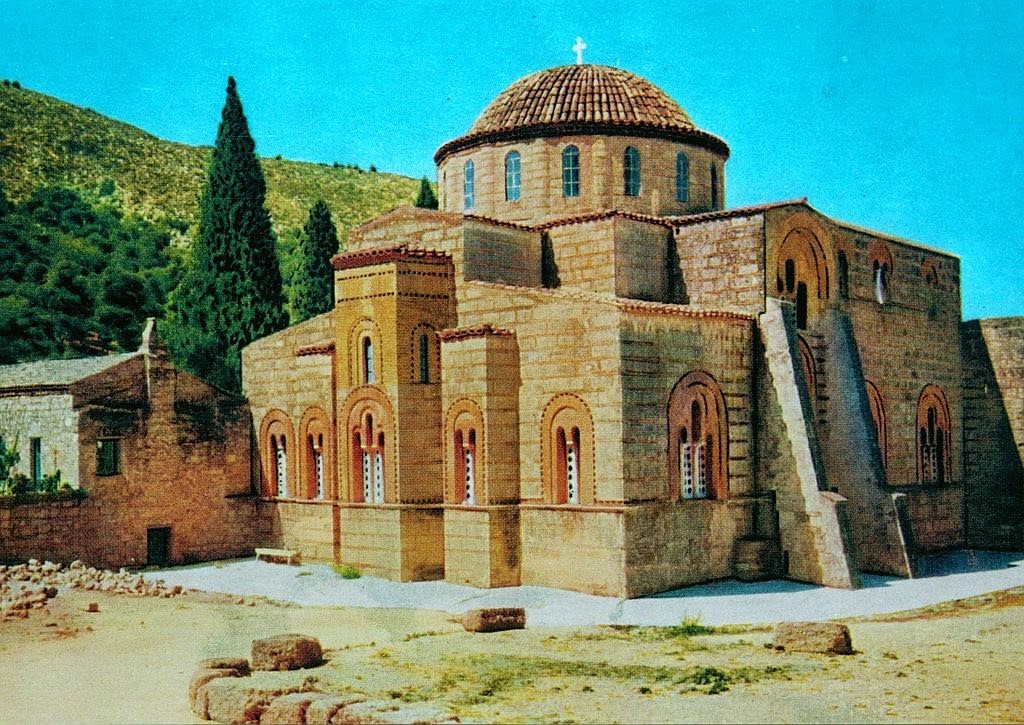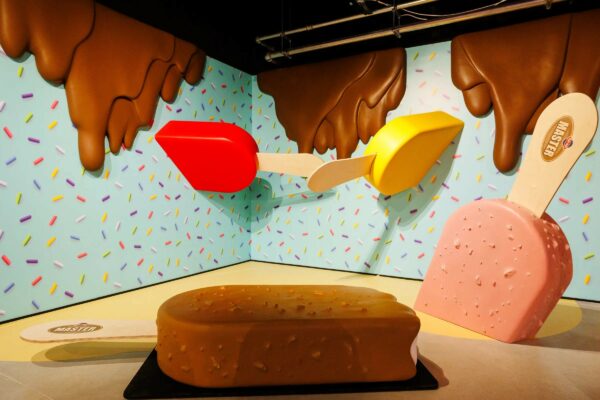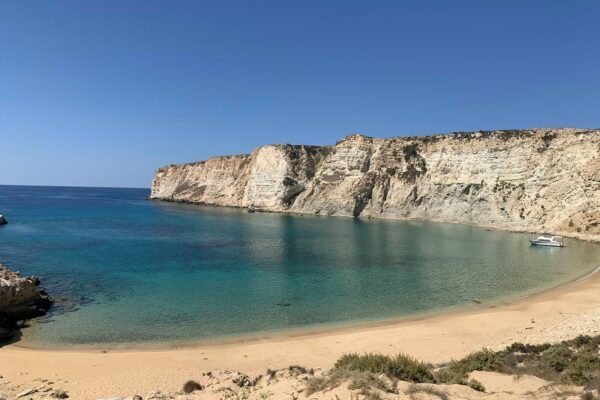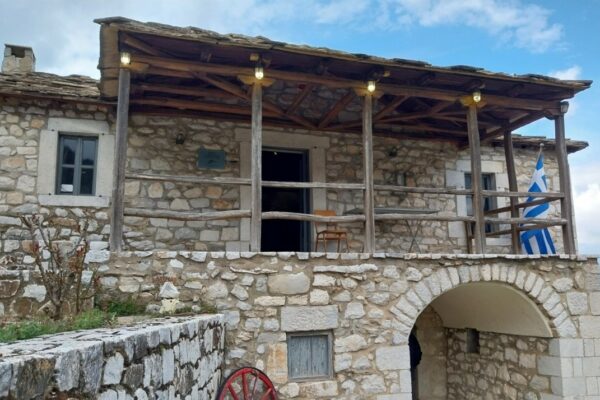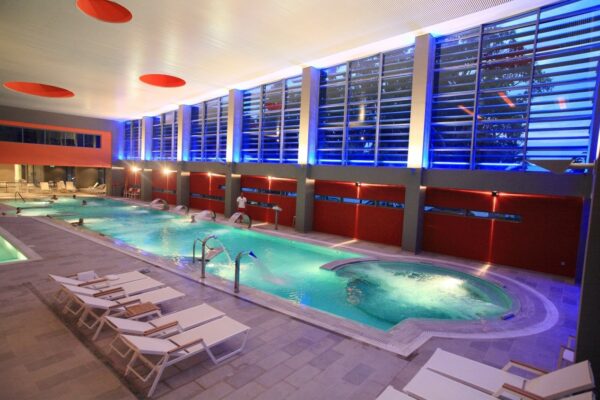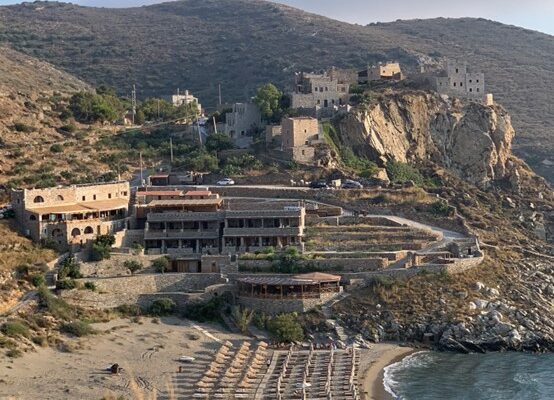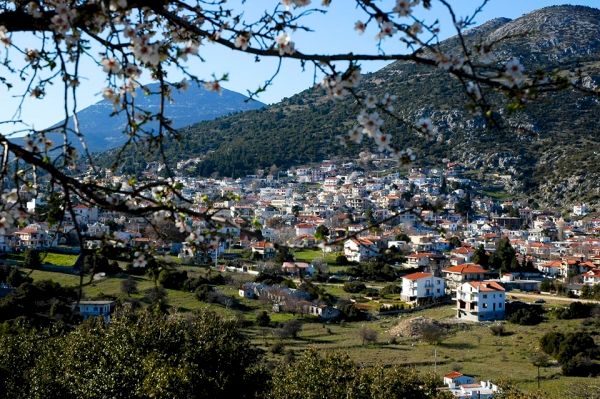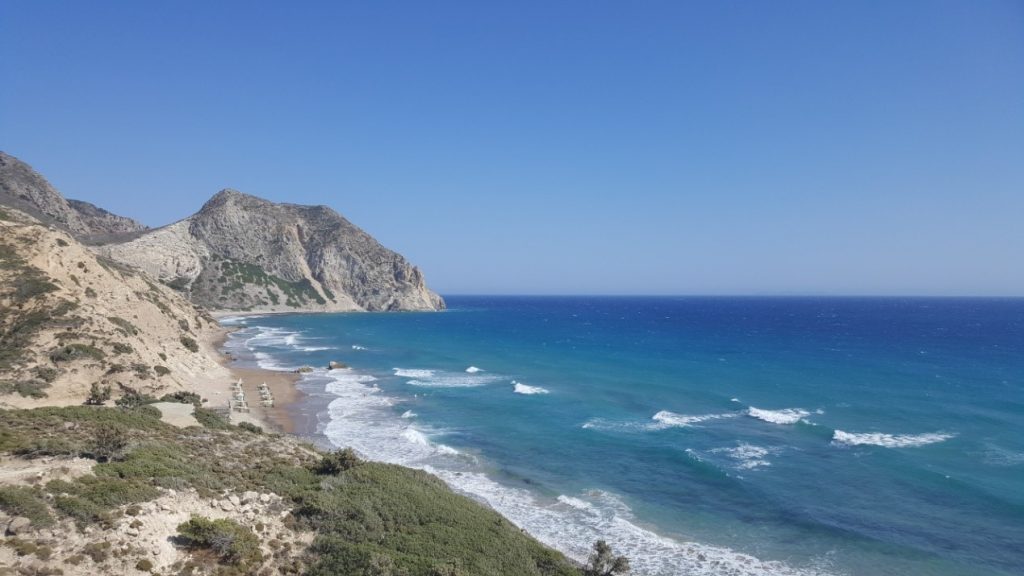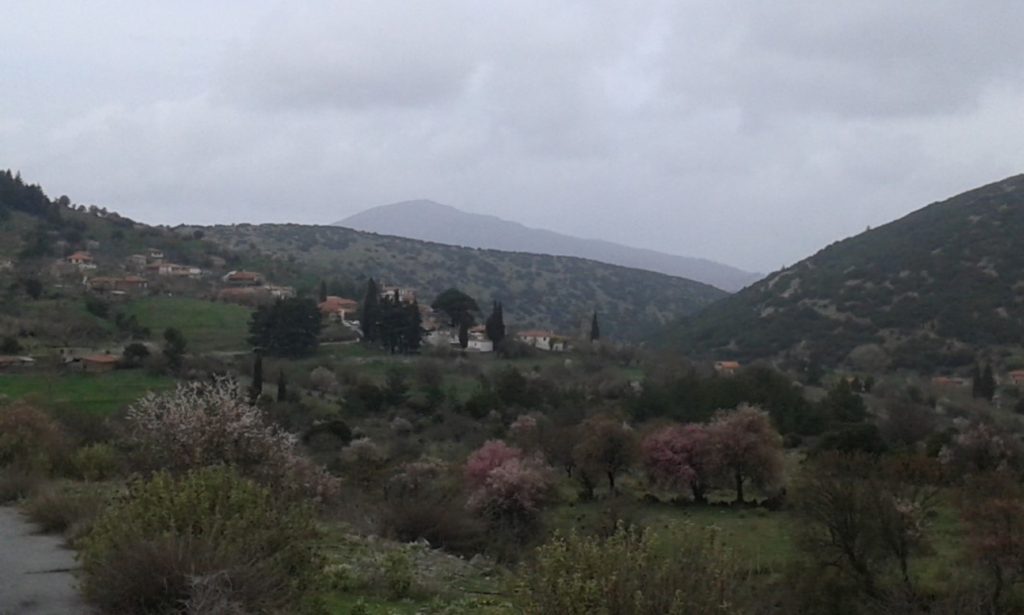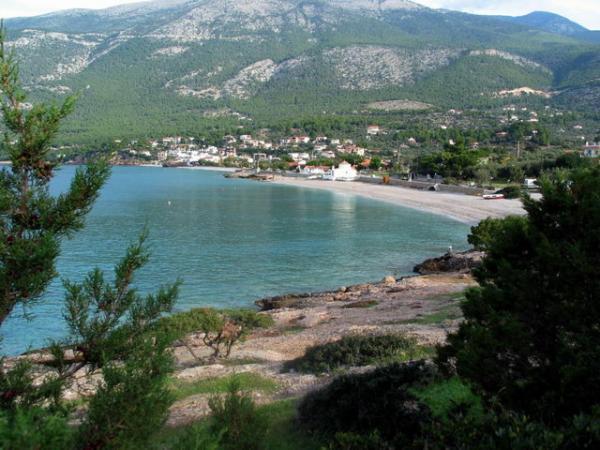Walk in Daphni Monastery
The Daphni Monastery located in Haidari area, of D.. Athens, on the outskirts of Variable Conditions. Considered one of the most important Byzantine monuments in Attica, with main attraction, mosaics.
The church of the monastery is cross-type complex, octagonal, with a large dome, rate adopted their middle Byzantine times (843-1204). It is the most important example of this type temple in Greece, together with the Monastery of Saint Luke, Fokis and Nea Moni of Chios. From 1990 included in the World Heritage List, UNESCO.
NAME OF THE MONASTERY
Pausanias mentions that the 2The century. It was in the position of today's monastery, the Sanctuary of Apollo Dafnaiou or Dafneiou, which was next to sacred Way, the road that led from Athens to Eleusis, where he celebrated the Eleusinian Mysteries. According to legend, Daphni name of the area comes from a Daphne queen. When the ship sank in the port of Elefsina, Scaramanga was saved because, to show its gratitude to Apollo, built the Temple of Apollo Dafneiou. Another legend says nymph Daphne to escape the amorous moods of Apollo transformed into plant, bay leaf, which abounds in the area.
ESTABLISHMENT OF THE MONASTERY
The exact date of the founding of Daphni Monastery is not known as there are no signs or other findings that attest to the creation of. It is known that 395 A.D. Goths destroyed the Sanctuary of Apollo Dafneiou. Then, when the spread of Christianity, on the ruins of the ancient sanctuary, It built a new temple. speculation, the Monastery of Daphni, protoktistike the 6The century. on the ruins of this temple and early Christian basilica type was. newer studies, place the foundation of the impressive monument, the 11The century.
HISTORY OF THE MONASTERY
- 1204, Athens was conquered by the Franks, which caused major disasters in Moni.
In Catholic monastery namely the dome, found stone arrowheads, close to the eye and the side of the mosaic depicting Christ Pantocrator.
- 1207, Monastery of Daphni captured the Order of Cistercian monks.
The Cistercian monks (Cistercian) It was a mixed religious, monastic Order of Roman Catholic Church, otherwise known as "The White Monks" or "Vernardinoi" established in 1098 A.D.
The monks remained in the Monastery 2,5 centuries and evicted, when the Turks, on Mohammed B, They captured the city. The Cistercian monks, around the end of 13th-14th century. They repaired the outer narthex of the Catholic Monastery that was destroyed after earthquake, replacing the original Byzantine arches with pointed Gothic. Also they progressed into elementary supports walls and dome through building walls. Themselves turned the crypt located underneath the narthex, a mausoleum, for the burial of the Duke of Athens.
- 1456, after the capture of Athens by Mehmed II’ Moni handed back to orthodox, wherein they proceeded with various additions, in cell formation, resident Abbot etc..
- 1821, during the Revolution, Turks occupy the Monastery causing extensive damage.
- 1838-1839, Barbarians settled soldiers, to supervise the narrow passage to and from Athens.
- 1840, French researcher of medieval history, Jean Alexandre Buchon visited the monastery and found it completely deserted.
- 1841, He arrived at the monastery, the famous Danish writer Hans Christian Andersen (1805-1875), who was impressed by the mosaics of the Catholic Monastery, diesoze that traces of the Byzantine splendor and annoyed by the Turkish disrespect, during the years of the Revolution.
- 1854, It was used as a camp for the French battalion that was installed in the monastery in order to protect from the terrible cholera epidemic that had broken out in the city. The commander of the battalion, General de Vasoignes, together with his soldiers cared for the cleanliness of the ruined monastery and made some excavations in the area around it.
- 1866, the author Emmanuel Rhoides (1836-1904), in the "Papissa Joanna project", It refers to the Byzantine splendor of the monastery.
The heroine, Pappisa Joanna, masquerading brother John, along with her partner, disguised in Frumentius father found peace and quiet in the Monastery of Daphni.
- 1883–1885, Daphni Monastery transformed into mental hospital. The cells of the monks repaired to accommodate patients and courtyard were rebuilt several outbuildings, significantly burdened the monument.
The first patients entered the monastery at 2 May 1988.
- 1886, earthquake caused significant damage to the Monastery
- 1887, used as poimniostasio, with cells Monks be converted into a stable.
- 1889 and 1894, earthquakes caused great damage to the monument.
- 1894-1974, Monastery gradually depopulated, which contributed to the deterioration of buildings, due to abandonment.
- 1990, when the monument entered the World Heritage List, found under the protection of UNESCO and thus necessarily renovated, restored and acquired its current form.
THE MOSAICS OF SINGLE laurels
The mosaic of the Monastery classified as masterpieces of Byzantine art (11th -12th century. A.D.), rival the big monumental churches of Constantinople. The brilliant mosaics of Daphni Monastery reveals that the donor must have been some emperor or other officer, possibly with some connection to Istanbul. The craftsmen and artists of the impressive mosaics apparently had called from there. The impressive mosaics adorn the walls, the dome, the Sanctuary and the roof. the forms, They have excellent ratios, moderate movements and show courtesy and morals, expression of persons.
Of the many issues mosaics, the 76 referring to the life of Christ and the Virgin Mary and the rest to the Saints and Prophets. The iconographic program largely follows the standards were established in Istanbul, after the end of Iconoclasm (726-787 and 815-843).
So in the church dome, dominates Christ Pantocrator surrounded by Prophets, to 4 imichonia, beneath the dome, are representations of the Annunciation, of Birth, Baptism, Metamorphosis and the sanctuary, Notre-Platytera accompanied Archagelon. At the higher surfaces of the temple wall, mosaics preserved in good condition, unlike the bottom surface, where mosaics dominated by Saints performances.
MOSAIC WITH CHRIST PANTOKRATORAS
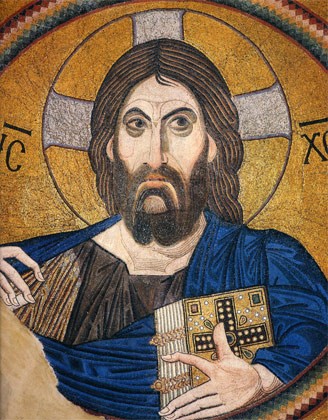
The impressive dome mosaic depicting Christ Almighty surrounded by 16 persons Prophets of the Old Testament. It is the largest, in size, mosaic representation Moni. Set in circle, symbolizing the sky and gold background, symbolizing heaven.
His face is severe expression as judging people for their actions, as "Righteous Judge". His look is throw, strict and piercing. The severity achieved strong arched eyebrows and dark shade beneath them and under the eyes. The dark, thick beard accentuate the impression of rigor. With his right hand blesses, while the left holds massive chrysodeto Gospel. The distance that separates the marker from the middle finger, on the Gospel, adds volume to gesture.
Persons Prophets other discern relaxed form, reminiscent of ancient philosophers and other sharp, stern look, imitating the look of Almighty. Note that initially, the forms of the mosaic locations, was not exactly in this place but because of the work rehabilitation interventions, amended.
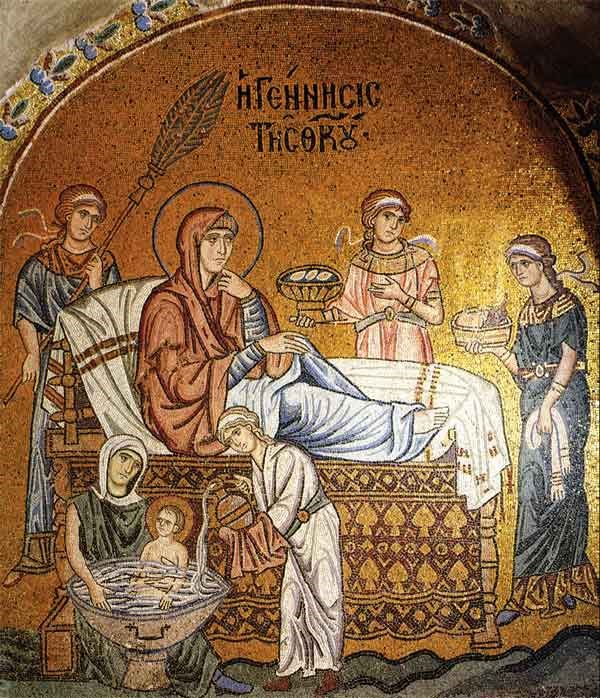
MOSAIC OF BIRTH OF MARY
Located in A. imichonio and impress the grandeur of space reminiscent of palace.
MOSAIC Annunciation OF VIRGIN
in NE. imichonio the scene of the Annunciation, Gold occurs in depth without the slightest statement landscape. The archangel Gabriel approaching calm, harmonic motion Notre, the tunic and the garment follow the movements of the body and the wings resemble the ancient statue of Victory. The Virgin on the right, a throne, with calm and gentle form, facing front, with the head turned slightly to the right. The wings of the Archangel and the garments of both forms are adorned in places with gold mosaic.
MOSAIC OF BIRTH CHRIST
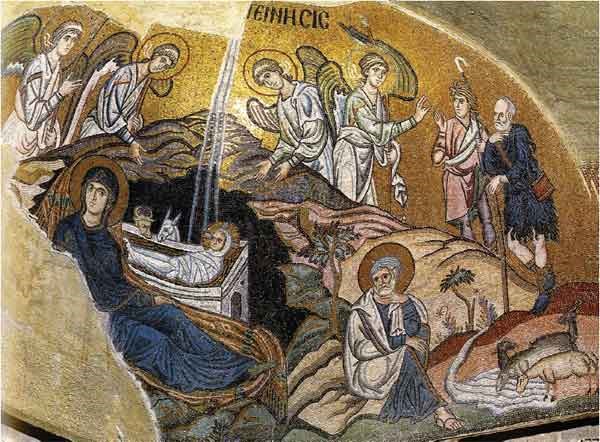
To. imichonio the Catholic Monastery, there is a mosaic of Birth. The artist places the rocky cave of the Nativity, in a landscape that exudes serenity. Gold mosaic on top, They show the bright light from the star, surrounding mild hills, shepherds and sheep to drink water from a stream. The figures of the Virgin, Joseph, the annunciator and shepherds are peaceful, the harmonious movements of bodies and persons designated by strong plasticity.
MOSAIC OF PROSKYNISIS the Magi
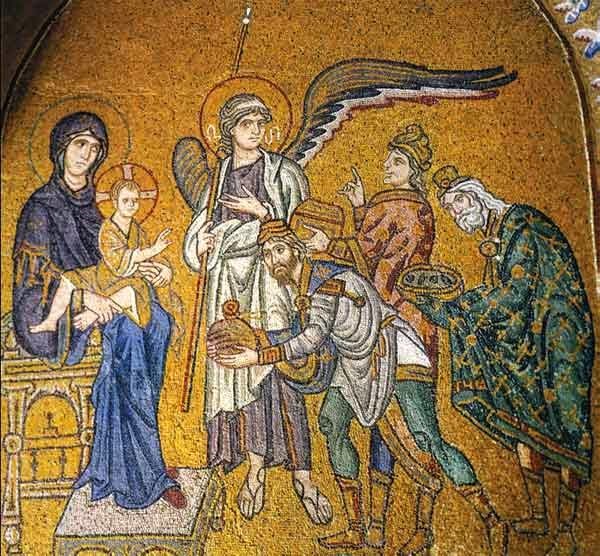
In Adoration of the Magi, Mary is seated in Throne Palace, Christ in her arms bless, with His right hand and the Magi arrive wearing formal clothes.
MOSAIC OF BAPTISM CHRIST
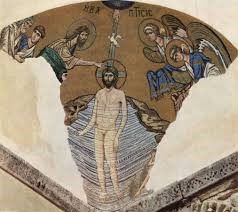
SW. imichonio depicts Baptism wherein rarely show Christ appears completely naked, reminiscent of ancient statue. Angels holding towels to wipe the body of Christ, after Baptism. The mosaic of the Transfiguration of the Savior, NW. imichonio, less preserved.
MOSAIC OF THE VIRGIN KOIMISIS
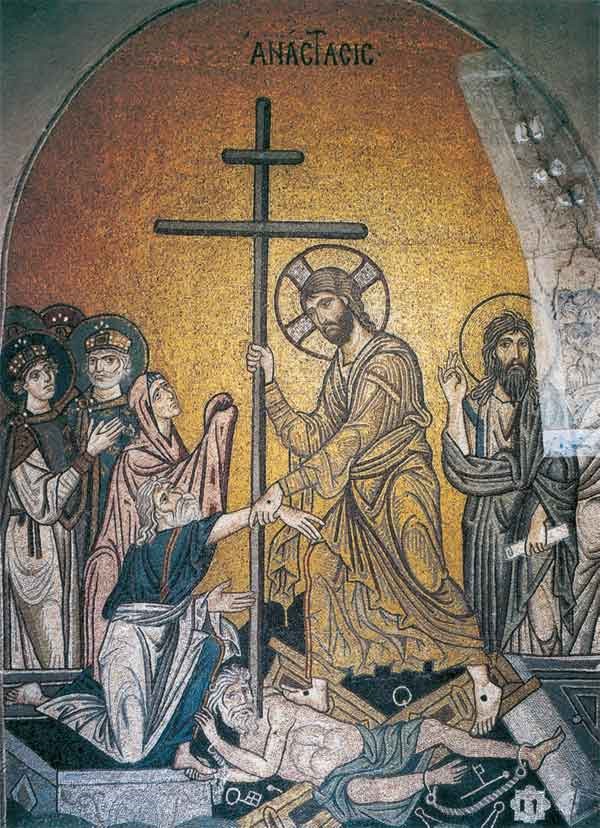
MOSAIC OF THE RESURRECTION
the mosaic, located in D. the temple, nearly destroyed. shows a angel descend from heaven, to receive the soul of Virgin. Characteristic of this mosaic is the thinking style of Angelos and his hands covered with fabric, apparently to put the soul.
THE ARCHITECTURE OF SINGLE laurels
The Daphni Monastery consists of Perivolos with Gates Entry, Catholic, the narthex and exonarthex, the monks' cells, the Bank, the galley, the baths, the Cistern and one room.
- Perivolos , strong, fortified, squares, with side about 97 m. Steve. side of the monastery Part of the wall is preserved in good condition.
Perivolos, height was 8 m. with "devil», i.e. interior corridor, latitudinal 1,6 m. wherein allowing the movement along the wall, the height of 6 m. The "devil" was supported by blind arcade. The Wall, along had Ramparts and towers of square plan. Three of them are still preserved and located in Northern. side of Perivolos. In building the Perivolo were used conglomerate cut into large rectangular length pieces 1,6 m. and height 0,4-0,6 m. Connected with mortar. The fortification wall, It was necessary because of the location of the monastery, in the distance 10 km from Athens, in desert area, near the port and near the road leading from the Peloponnese to Athens.
- Main Gate Monastery, It was in the middle of the D.. side Perivolos, i.e. opposite the entrance Ledger.
It was protected by a fortification Tower, who stood over her and was supported by two side Bastions. So, for someone to enter the monastery courtyard had to pass the "passageway», i.e. the arched treadmill, length 6 m. which opened under the Tower.
- secondary Gate, is located 8 in the middle of the A. side of Perivolos and is today the main entrance of visitors.
The existence of two entrances in Perivolos, Monastery of Daphni, It shows magnificence as not seen in other monasteries of the time.
- ledger, ie the nave, belongs to 11th century. and belongs to the type of the composite octagonal, domed.
outwardly, the nave gives the impression of a large cube, with a building brick, supporting a tall dome. internally, The dome is supported by heavy 8 strong quadrangular brackets (piers), four freely and four embedded walls. Characterization octagonal resulting from the Eightfold support the dome. the pillars, arranged pairwise, forming 4 imichonia (angular niches) which bridge the corners of the square base and convert it into an octagon. On this rests the great dome. Architectural reminds how support domes temples in Istanbul (10th -11th c.). The space under the dome, open and uniform and the light is evenly distributed in space, through the 16 windows of the dome.
- Splints, in West. side of the church, wherein attached and exonarthex.
- Outer narthex or porch, It has an open loft form floor.
There must have been the residence of the Abbot and the Library.
In exonarthex there are traces of frescoes (12th– 13th c.) while the temple have been found post-Byzantine frescoes (17th c.). in D. the exonarthex attached during the Turkish chapel with holy rotating northwards.
- Monks' cells, Cells were both B. side of the wall, which was attached to Perivolos and on D.. side of, Nearby than that formed, a narrow corridor.
Stan. Cells is the Catholic group with arcades, which is built around a small square courtyard. These built by Cistercian monks and remodeled in the Orthodox 16The century.
- Bank and galley, to B. the Catholic, where some ruins are preserved.
The A. side occupied by arch, semicircular inner and outer semi-hexagonal. The circular building, has found attached to B. side of the Bank(dinning room), It was the galley of the Monastery.
- baths, SW. the Catholic, only preserved the hypocaust, i.e. there that produces hot water.
The existence of baths, a monastery, It was not uncommon and suggest acne and prosperity.
- cistern, tank to collect rainwater nerou.Vriskotan SW. where the Catholic detected rectangular building basement, below the cells. The Cistern was two-aisled with arches and water collection was through circular openings. Similar aisled cisterns have been located at the Monastery of St. Luke and St. Sophia at Mystras.
- Room, Stan. the Catholic.
the ruins of a dimensional hall 23.0 found×6,5 m., oriented EW, mesobyzantine typical masonry and floor covered with clay plates. Along the B. and N. walls were columns. The available data do not allow determining the use of the hall.
ACCESS
The Monastery of Daphni is the center of the capital 10 km and is accessible from the National Road. Athens - Corinth, as follows :
- by private car. the National Road. Athens-Corinth, Going Green in the eponymous region.
- with Measure, line 3, Airport-Agia Marina and then to the bus line, NThe 866, f. Agia Marina-Aspropyrgos (attitude Daphni Monastery), NThe 876, f. Agia Marina- Eleusis, Aspropyrgos (attitude Daphni Monastery) and NThe 811, f. Agia Marina-Haidari (roundabout, Mental attitude).
THE SURROUNDING AREA OF SINGLE laurels
Around the monastery, the Municipality of Haidari, It has built a tourist kiosk where you can drink coffee or eat. In the courtyard, which is configured, every year cultural events, with leading the "Chaidariotika Koulouma", Clean Monday.
USEFUL ADDRESSES
- IM. Daphni, Haidari, tel. : 2105811558, free entrance, Tuesday - Friday, visiting hours : 8:00-15:00.
- Municipality of Haidari, Str street. Karaiskakis Epafleos, Haidari, tel.: 2132047200, 2105324600, www.haidari.gr

